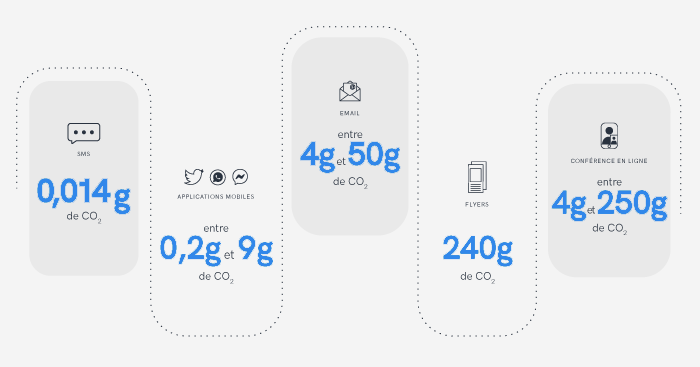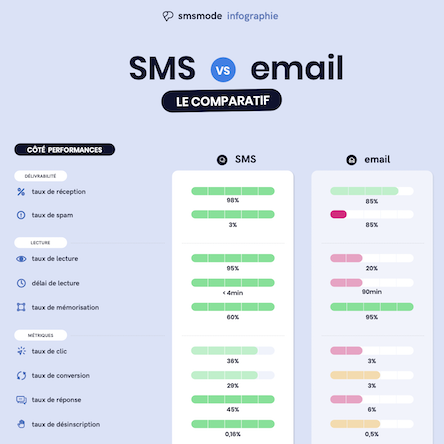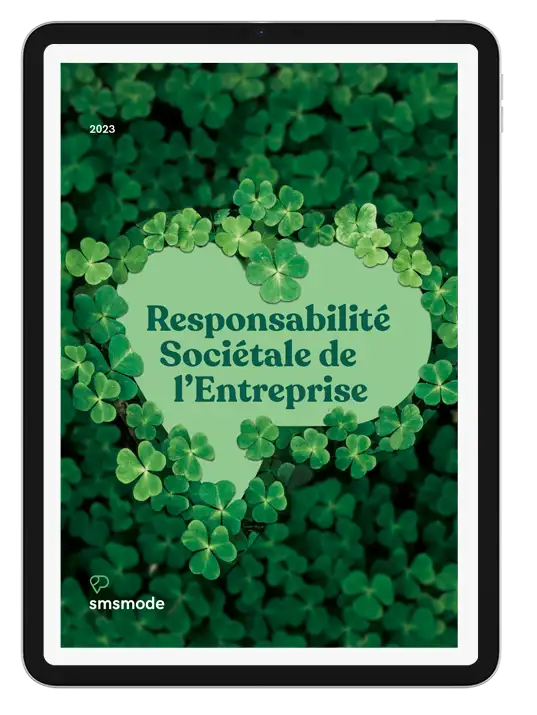Share :
Introduction
Looking for pollution-free interaction? It's not just the content of a message that can demonstrate your commitment to the environment - the choice of channel can also make a difference! Find out why SMS is the eco-friendly medium par excellence, and how it fares against e-mail, social networks and paper leaflets.
Marketing footprint: a challenge for everyone
The question of our impact on the planet is becoming increasingly important. And while it's easy to imagine the pollution generated by our travels and waste, it's not so easy to quantify the CO2 emitted by our digital habits. Yet digital was responsible for 3.6% of globalCO2 emissions in 2023 and could reach 6.7% by 2040 according to ADEME.(1) and Arcep(2). By way of comparison, this is twice the amount of air traffic generated by aviation. In the light of these figures, each of our actions can be questioned, and the energy consumption of digital marketing is no exception.
So when it comes to planning a marketing campaignquestions arise: "Does my campaign pollute?
"What are the energy costs of the SMS, emails, WhatsApp I send?"
"What media should we use to reduce our carbon footprint?
Many people have looked into these questions, and the answers are unanimous: of all existing media, SMS produces the leastCO2!
Why do digital exchanges emit CO2?
Digital pollution comes mainly from the use of the Internet's data flow. The exchange of information stored on servers in data centers, which is then consulted by smartphones, PCs or tablets. At every stage of this process, energy is consumed,CO2 is emitted and the balance sheet becomes heavier.
With SMS, there are fewer intermediaries and less data. It uses the frequencies and network of conventional telephony, so the route is more direct between sender and receiver. As a result, usage is reduced to almost nothing more than the power required to power the devices. Another environmental advantage is that the short message is received on a cell phone rather than on a computer, which reduces the resources required to power the device and the energy cost of the operation.
SMSemail, instant messaging, calls, videoconferencing, flyers... a comparison ofCO2 emissions by media.
We owe most of these calculations of the carbon footprint of mobile notifications to Mike Berners-Lee, researcher at Lancaster University and author of "How bad are bananas? The carbon footprint of everything" (he's also the brother of one of the inventors of the Web: Tim Berners-Lee).

According to the information he has gathered, e-mail is the most polluting medium.
The gas emissions of an e-mail vary according to its content: from 0.3 g ofCO2 for a spam message to 4 g for a standard e-mail, and up to 50 g ofCO2 when it contains a photo or a large attachment. What's more, these figures were calculated by Berners-Lee ten years ago. Charlotte Freitag, one of the experts at the company founded by Berners-Lee (Small World Consulting), believes that the impact of sending e-mails has certainly increased since then, as their content has evolved. The number of e-mails has also exploded: every day, 347.3 billion electronic notifications are sent around the world, 80% of which are never opened.
A tweet is estimated to have aCO2 footprint of 0.2g ( Twitter has never confirmed or denied this figure), while sending a notification via a messaging application such as WhatsApp or Facebook Messenger is estimated to be barely less polluting than sending an e-mail. Again, this depends on the content being sent: GIFs, emojis and images have a larger footprint than plain text.
Texting is by far the most environmentally-friendly alternative, as each text generates just 0.014g ofCO2. Others, like Frédéric Bordage of GreenIt.fr, even estimate that texting emits 0.00215 g ofCO2 (calculation based on information provided by Vodafone). Even extending the calculation of the text message's carbon footprint to Scope 3 (which designates the broadest perimeter within which greenhouse gas emissions are studied. Emissions from the company providing the sending service, from the working lives of its employees, from the manufacture of telephones, etc.), SMS remains the marketing channel with the smallest footprint (0.19g ofCO2 emissions) .
The ultimate feature comparison (to help you make the right choice)

The gas emissions associated with a one-minute phone call on a cell phone are slightly higher than those of sending a SMS, but those of video calls on the Internet are astronomical. A 2012 study by the University of New South Wales (Sydney) estimated that a 5-hour videoconference meeting between participants from different countries produced between 4 kg and 215 kg ofCO2.
And what about printed advertising?
Mike Berners-Lee estimates that an advertisement sent by post is responsible for sixty times moreCO2 emissions than an e-mail, i.e. 240g per recipient. However, while this calculation certainly makes sense per unit, many parameters are not taken into account, such as the fact that paper can be recycled (which is the case for paper used in direct mail in over 60% of cases).
What's more, the trees saved by recycling paper offset some of the emissions by absorbing carbon dioxide.
Some other figures
2 Google searches emit 14 grams ofCO2 into the atmosphere, as much as heating a cup of tea (calculation by physicist Alex Wissner-Gross (Harvard), which does not take into account environmental degradation and the energy expended by servers).
65 emails emit as much as one kilometre by car.
Spam-relatedCO2 emissions over a year are equivalent to 3 million cars burning 7.5 billion liters of gasoline (McAfee report "The carbon footprint of spam").
17 million tonnes ofCO2 are emitted every year for sending and filtering spam (80% of all e-mails in circulation).

How do you calculate your carbon impact?
You can only improve what you can measure. So.., smsmode© has chosen to work with an industry expert to measure its carbon impact.
First of all, you need to define your scopes, i.e. the scope of the activities concerned.
- Scope 1 covers the direct emissions of greenhouse gases produced by the company: fossil fuel combustion for space heating, emissions from company vehicles, etc.
- Scope 2 includes indirect energy-related emissions, i.e. those created during the product production process. This represents the energy carbon footprint.
- Scope 3 covers all the company's indirect emissions. In general, most of the emissions produced by the company are included in this scope: purchase of goods, services, etc.
These scopes are then broken down into 22 sub-categories.
Where does the analyzed information come from?
The data required for this calculation comes, among other things, from the Fichier des Écritures Comptables (accounting entry file), a Questionnaire for employees to find out a little more about their modes of travel to work, their eating habits on site, etc.
Next, a categorical benchmark is carried out, comparing each of the company's waste items with companies in its sector. The aim is to rank your company in relation to those already ranked.

Make SMS an "eco-responsible" asset for your company
The impact of your communications activities can be a cause for concern. Fortunately, it's possible to opt for eco-responsible solutions that will benefit your company in many ways. If you want to initiate greener exchanges, here are 7 good reasons to opt for short messages!
A channel strongly recommended by ADEME
In fact, the French environment agency recommends SMS as a way of overcoming the logic of "all paper" and distributing its promotional offers in a more eco-friendly way.
A virtuous "quick win" action
Start at the beginning, with concrete actions that can be launched quickly. The SMS marketing is as easy, if not easier, to set up than most other exchange channels: it's within everyone's reach, and that's a good reason to take the plunge.
An eco-friendly (first) step with far-reaching effects
By opting for shipments of SMSyour commitment to the planet becomes real. For every 100,000 SMS sent, you can reduce your carbon footprint by almost 5 tonnes. To put it simply, switching from an e-mail campaign to SMS means saving the equivalent of 26,000 km by car!
No compromise on efficiency and performance
SMS has a 95% open rate within 3 minutes of receipt, is a very personal way of reaching your customers, and is the perfect tool for relaying the information you want to share with your customers.
Improved brand image thanks to its eco-responsible approach
With customers and prospects increasingly demanding a commitment to sustainable development, launch your digital anti-pollution strategy! Promoting the environmental initiatives you've adopted will enable you to be more in tune with today's global challenges, and set you apart from your competitors.
A responsible medium that doesn't necessarily cost more
It's true that an e-mail campaign costs less to send. But if we compare the cost per notification actually opened and per person reached, the gap narrows considerably. In fact, with only 20% of messages sent being opened (compared with 95% for text messaging), the cost of an emailing campaign is almost quintupled! What's more, the ROI of SMS is unbeatable.
Communication at the heart of the CSR (Corporate Social Responsibility) approach
Eco-design and the choice of information media based on limiting environmental impact are among the 3 pillars of the CSR approach for marketing professions defined by ADEME.
Decarbonize your shipments with smsmode©
Thanks to smsmode© and its partner ecotreeMake your marketing carbon footprint go green! For each subscription, smsmode© plants between 1 and 50 trees in the Forêt de Berné (a tree absorbs between 10 and 40 kg of CO2 per year).
More than enough to compensate for your mobile messaging consumption 😉.
Our CSR report describes 9 key sustainable development actions implemented on our platform.

Conclusion
At smsmode©We are convinced that tomorrow's exchanges will involve the choice of environmentally-friendly tools. This is a fundamental trend, and one that companies will have to face up to in the years to come. With its 160 characters, mobile messaging remains the surest way to reduce your company's digital footprint, show your commitment to the environment and... make digital interaction rhyme with ecology!
Create your free account
Try out our SMS platform and benefit from 20 free test credits, with no obligation.

